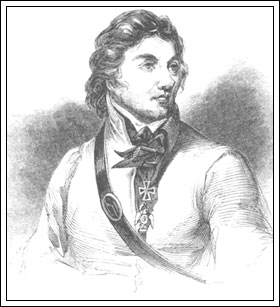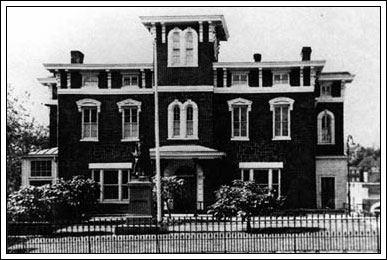|
COPCUTT'S GHOST ROBS KOSCIUSKO'S STATUE OF SWORD
Yonkers Poles Offer Reward for Its Capture and Guard
Bronze Figure Nightly.
FEAR CONVENT HAUNTED
Apparitions That Spread Terror at Old Mansion for Two
Decades Are Seen Again After a Long Silence---Polish Society
Is Aroused.
New York, June 8.---Old John Copcutt's ghost which
has haunted the Copcutt mansion in Nepperhan avenue,
Yonkers, for two decades, puzzling spiritualists,
defying capture and spreading terror among superstitious
and unsuperstitious, has appeared again, and this time
has wreaked his vengeance on the $12,000 statue of
Kosciusko, the Polish patriot, which was unveiled on
Decoration day. This last act of vandalism has so
aroused members of the United Polish society of Yonkers, who
erected the statue, that they have offered a reward of $700
for the capture of the ghost. The Rev. Father Dwoizak,
pastor of St. Casimir's Roman Catholic church, purchased the
Copcutt property three years ago, and turned it into a
convent. He was active in erecting the monument on the
estate and will swell the reward to $1,000. |
June 9, 1912
Thaddeus Kosciusko
Polish Son of Liberty
Hero of the American Revolution

GHOST
CLIPART INDEX
NEWSPAPER ARTICLES HOME |
Since 1907, when Frederic D. Hughes won a $50 prize by writing
the best ghost story for the Sunday World by telling of his personal
experiences with old Copcutt's shade, it has appeared on rare
occasions. What Made Hughes Move.
Hughes and his family lived in the house, they having gone there
in 1908, after it had been vacant for years. Hughes was not
afraid of ghosts: neither was his wife nor other members of his
household. But they had not been in the old mansion long
before the Copcutt ghost decided they must not live there. The
ghost, his face leering and vicious, would appear nightly.
Hughes wrote. Every night as the clock struck 12 a beautiful
woman, dressed in black, would flit into one of the rooms and at the
same time the dumbwaiter would begin to move up and down. No
man had sufficient strength to stop this waiter, and for five
minutes it would rattle and shake on its shaft. One night an old
carry all driven by the ghost of Jeremiah Linehan, a coachman and
confident of Copcutt, who was as mysterious as his master in life
and was his ghostly associate after death, rolled up to the mansion
door. Hughes declares that old Jeremiah, his face lined with
viciousness, leered up at him and drove on. Then the driver
and vehicle disappeared in air. Another night Copcutt came up to
Hughes in the library and snarled, "The place is cursed! The place
is cursed!" The next evening Hughes and his wife were on the lawn,
and on the very spot where the Kosciusko monument now stands old
Copcutt seemed to rise from earth, and tottering forward, his body
wriggling, he squealed: "This place is cursed; The trees will die!
No mortal man will remain in the abiding place of spirits!" Nuns
Terror Stricken.
A few days later the trees began dying and the ghost continued
their operations until Hughes decided he would move. Professor
James Hyslop and Dr. Isaac K. Funk, the psychic researchers, and
other men of their kind spent nights in the mansion. They saw
ghosts and they marveled.

Copcutt Mansion
When Father Dwoizak, whose church
adjoins the Copcutt property, bought the place it was supposed the
ghosts had given up their weird pranks. The old mansion was
made into a convent and if the nuns ever saw the ghosts they never
spoke of it. The unveiling of the statue was the principal event
in Yonkers on Decoration day. The figure of the patriot is in
bronze, standing on a stone pedestal. In his right hand
Kosciusko holds a parchment and his left rested on his sword
scabbard. Monday night last the nuns saw from their windows
ghostly figures flitting about the trees and around the statue.
They became terror stricken. There was no telephone in the
house and no means of communicating with the police. Next
morning it was found that the ghosts had robbed Kosciusko of his
sword and carried it off. Syracuse Herald, Syracuse, New York -
Sunday, June 9,
1912
You are the light
in my hand
As a wind rush might be,
Ay, so light
As the froth on the sand
Or the foam on the sea,
And as bright
When you felt the
red fire
Of the forge, as it played,
Did you feel,
Too, my swordsman's desire
Run like blood on your blade
And blue steel?
Ernest Rhys, The Swordsman to His Sword (Broadside, 1908)

|